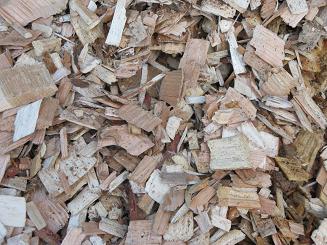By B. Jackson, R. Schroeder, and S. Ashton
Biomass feedstock moisture content is dependent on post-harvest handling and storage conditions. Moisture may be lost by transpiration drying, through foliage, or from open wood surfaces. The rate of drying depends on many factors including ambient temperature, relative humidity, wind speed, season, rainfall pattern, tree species, and tree size. The best season for drying usually is dry summer in the South.
Transpirational drying, also known as “leaf seasoning”, “biological drying”, and “delayed bucking” occurs when felled trees are left for several weeks with the tops, branches, and leaves intact (Stokes and Kelly 1993). Such drying can be successfully used with most species. Moisture contents as low as 30 percent may be reached under favorable conditions.
Research studies have been conducted on transpirational drying in the US, and a review of several studies is reported by McMinn (1986) and Stokes and Kelly (1993). They report several earlier findings related to transpirational drying, including the following.
- There is little or no difference in moisture content of red oak trees felled with tops intact and dried for three weeks compared to similar trees felled, bucked and stacked for the same period. In the same study, paper birch showed significant moisture loss.
- Loblolly pine, white oak, and sweetgum logging residues were compared for moisture loss. Results showed higher moisture losses in pine, less moisture loss for sweetgum, and the least for oak. It was recommended allowing residues to remain in the woods for 10 to 12 weeks in the winter to reduce moisture content.
- In Virginia, it was shown that after four months of field drying, minimum moisture contents were approximately 29 percent. The main drying variables identified were season of felling, species, and diameter. The net energy value increased up to 50 percent (pine heartwood).
- Results for eucalyptus and slash pine in Florida showed that the season of felling significantly influenced the drying of pines, and that at least four weeks of drying may be needed for optimal drying.
Stokes (1987) provides a basis for predicting transpirational drying of species groups in the southern US based on these variables. It was noted that pine stem weights began to stabilize after about 50 days, soft hardwoods after about 30 days, and hard hardwoods after 40 days. Moisture contents after that period were about 37 percent for pine, 33 percent for soft or low-density hardwoods, and 32 percent for hard or high-density hardwoods (wet weight basis). This pretreatment is important from the standpoint of transport costs as well as combustion efficiency. Each transport load of drier wood will carry less water. Assuming total payload capacities stay the same, there will be more wood (and less water) delivered per load. This will reduce the transport cost per unit of wood, and reduce the amount of water being handled, transported, and evaporated through combustion.
Additional research was performed on another approach to field drying. Sirois and others (1991) reviewed tests performed on a prototype roller crusher. This machine was designed to crush round, smaller diameter stems and facilitate drying by opening the wood to transpirational drying effect. The study found that crushing facilitated drying during periods when rain was absent, and any drying benefit was attained during the first five weeks of drying. The study concluded that there is no guaranteed benefit from crushing trees to increase the rate of moisture loss over long drying periods or periods of heavy rainfall.
Excessive precipitation or low temperatures may hinder the efficiency of transpiration drying (Lehtikangas and Jirjis 1993a). If on-site storage is extended to late fall or even until winter in temperate countries, the advantage gained by transpiration drying will be lost due to absorption of moisture directly from the air and from precipitation (Lehtikangas 1991). One benefit of on-site storage in small heaps is that leaves may be left in the forest, resulting in reduced nutrient loss from the site and better fuel quality.
References
- Lehtikangas P. 1991. Logging residues in piles – needle loss and fuel quality. Report No 223. Sverigaes Lantbruksuniversitet: Institute for Virkeslara. 33 p.
- Lehtikangas P, Jirjis R. 1993a. Storage of softwood logging residues in windrows under variable conditions. Report No 235. Sveriges Lantbruksuniversitet: Institute for Virkeslara. 45 p.
- McMinn J W. 1986. Transpirational drying of red oaks, sweetgum, and yellow-poplar in the Upper Piedmont of Georgia. Forest Products Journal. 36: 25-27.
- Sirois DL, Rawlings CL, Stokes BJ. 1991. Evaluation of moisture reduction in small diameter trees after crushing. Bioresource Technology. 37: 53-80.
- Stokes BJ, McDonald TP, Kelley T. 1993. Transpirational drying and costs for transporting woody biomass – a prelimary review. In: IEA/BA Task IX, Activity 6: Transport and Handling. New Brunswick, CN: IEA: 76-91.
- Stokes BJ, Watson WF, Miller DE. 1987. Transpirational drying of energywood. ASAE Paper 87-1530. St. Joseph, MI: American Society of Agricultural Engineers. 14 p..
